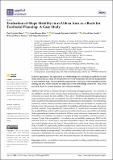Por favor, use este identificador para citar o enlazar a este item:
http://hdl.handle.net/10261/267662COMPARTIR / EXPORTAR:
 SHARE SHARE
 CORE
BASE CORE
BASE
|
|
| Visualizar otros formatos: MARC | Dublin Core | RDF | ORE | MODS | METS | DIDL | DATACITE | |

| Título: | Evaluation of Slope Stability in an Urban Area as a Basis for Territorial Planning: a Case Study |
Autor: | Carrión-Mero, Paúl; Briones-Bitar, Josué; Morante Carballo, Fernando; Stay-Coello, David; Blanco-Torrens, Roberto; Berrezueta Alvarado, Edgar Raúl | Palabras clave: | Stability Susceptibility to detachment Susceptibility to sliding Simplified Bishop method Geomechanical characterisation |
Fecha de publicación: | 28-may-2021 | Editor: | Multidisciplinary Digital Publishing Institute | Citación: | Applied Sciences 11 (11); 5013 (2021) | Resumen: | [EN] Slope stability is determined by pre-conditioning and triggering factors. The evaluation of the stability by scientific criteria provides crucial input into land-use planning and development. This work aimed to evaluate the slope stability of ‘Las Cabras’ hill (Duran, Ecuador) through geological and geotechnical analysis and a susceptibility assessment that allowed the definition of areas potentially susceptible to landslide and detachment for land planning recommendations. The methodology included (i) analysis of background information about the study area; (ii) fieldwork, sampling and laboratory tests; (iii) assessment of susceptibility to landslides and detachment through a theoretical-practical evaluation (using suggestions by various authors); (iv) a safety factor assessment employing the simplified Bishop method; and (v) analysis of the relationship between susceptibility and stability. Sixteen geomechanical stations were evaluated. Of these, seven stations are characterised as category III (medium susceptibility), six stations as category IV (high susceptibility) and three stations as category V (very high susceptibility). According to the susceptibility zoning map, 58.09% of the total area (36.36 Ha) is in the high to very high susceptibility category. The stability analysis based on 16 critical profiles shows that three of these profiles have safety factor values of less than one (0.86, 0.82 and 0.76, respectively), and two profiles have values close to one (1.02 and 1.00). The northern area is conditioned mainly by a vertical slope with an outcrop of fractured and weathered sandstones, thereby favouring rockfall. The landslide vulnerability in the case of the southern zone is principally conditioned by the fact that the slope and dip are parallel. The described characterisation and susceptibility analysis provide a basis for security measures and territorial planning. | Descripción: | 22 p. - Supplementary Materials available online at https://www.mdpi.com/article/10.3390/app11115013/s1. | Versión del editor: | https:// doi.org/10.3390/app11115013 | URI: | http://hdl.handle.net/10261/267662 | DOI: | 10.3390/app11115013 | E-ISSN: | 2076-3417 |
| Aparece en las colecciones: | (IGME) Artículos |
Ficheros en este ítem:
| Fichero | Descripción | Tamaño | Formato | |
|---|---|---|---|---|
| evaluation_slope_stability_2021.pdf | Artículo | 2,33 MB | Adobe PDF |  Visualizar/Abrir |
CORE Recommender
SCOPUSTM
Citations
17
checked on 19-may-2024
WEB OF SCIENCETM
Citations
7
checked on 27-feb-2024
Page view(s)
66
checked on 22-may-2024
Download(s)
273
checked on 22-may-2024
Google ScholarTM
Check
Altmetric
Altmetric
Este item está licenciado bajo una Licencia Creative Commons

